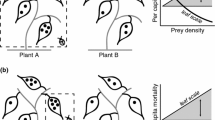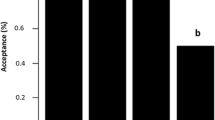Summary
Prey-size selection by the carabid beetle Notiophilus biguttatus F. was studied, using prey belonging to two-size-classes of the spring-tail species Orchesella cincta (L.) (Collembola). The highest values for attack readiness and success ratio of the attacks were obtained for the smaller prey animals. A model for prey-size selection was constructed in which these two parameters are included, predicting an increasing chance of incorporating large prey in the diet with declining total prey density. This prediction was tested experimentally and qualitatively confirmed. In a quantitative sense, however, the results deviated from the expectation. This was caused by a greater attack readiness of the beetles in a semi-natural environment (in which the prediction was tested) than in the artificial environment in which the parameters had been estimated. General relevance of the results, their bearing on optimal foraging theory and their ecological implications are discussed.
Similar content being viewed by others
References
Anderson JM (1972) Food and feeding of Notiophilus biguttatus F. (Coleoptera: Carabidae). Rev Ecol Biol Sol IX 2:177–184
Charnov EL (1976) Optimal foraging: attack strategy of a mantid. Am Nat: 141–151
Conover WJ (1971) Practical nonparametric statistics. Wiley, New York
Curio E (1976) The ethology of predation. Springer-Verlag, Berlin
Dill LM (1975) Predatory behaviour of the zebra spider, Salticus scenicus (Araneae” Salticidae). Can J Zoöl 53:1284–1289
Drees O (1952) Untersuchungen über die angeborenen Verhaltensweisen bei Springspinnen (Salticidae). Z Tierphychol 9:169–207
Ernsting G, Jansen JW (1978) Interspecific and intraspecific selection by the predator Notiophilus biguttatus F. (Carabidae) concerning two collembolan prey species. Oecologia (Berl) 33:173–183
Ernsting G, Joosse ENG (1974) Predation on two species of surface dwelling Collembola. A study with radio-isotope labelled prey. Pedobiologia 14:222–231
Estabrook GF, Dunham AE (1976) Optimal diet as a function of absolute abundance, relative abundance, and relative value of available prey. Am Nat 110:401–413
Freed AN (1980) Prey selection and feeding behaviour of the green treefrog (Hyla cinerea). Ecology 61:461–465
Gardner BT (1966) Hunger and characteristics of the prey in the hunting behaviour of salticid spiders. J Comp Physiol Psychol 62:475–478
Holling CS (1959) The components or predation as revealed by a study of small-mammal predation of the European Pine sawfly. Can Entomol 91:293–320
Ivlev VS (1961) Experimental ecology of the feeding of fishes. Yale University Press, New Haven, Connecticut
Joosse ENG (1970) The formation and biological significance of aggregations in the distribution of Collembola. Neth J Zoöl 20:299–314
Kislalioglu M, Gibson RN (1975) Field and laboratory observations on prey-size selection in Spinachia spinachia (L.). Proc 9th Europmar Biol Symp H Barnes, Aberdeen University Press, pp 29–41
Kislalioglu M, Gibson RN (1976) Some factors governing prey selection by the 15-spined stickleback, Spinachia spinachia (L.) J Exp Mar Biol Ecol 25:159–169
Krebs JR, Erichsen JI, Webber MI, Charnov EL (1977) Optimal prey selection in the great tit (Parus major). Anim Behav 25:30–38
MacArthur RH, Pianka ER (1966) On optimal use of a patchy environment. Am Nat 100:603–609
Pulliam HR (1974) On the theory of optimal diets. Am Nat 108:59–73
Schoener Th W (1971) Theory of feeding strategies. Ann Rev Ecol Syst 2:369–404
Werner EE, Hall DJ (1974) Optimal foraging and the size selection of prey by the bluegill sunfish (Lepomis macrochirus). Ecology 55:1042–1052
Wilk MB, Shapiro SS (1968) The joint assessment of normality of several independent samples. Technometrics 10:825–839
Author information
Authors and Affiliations
Rights and permissions
About this article
Cite this article
Ernsting, G., Mulder, A.J. Components of predatory behaviour underlying density-dependent prey-size selection by Notiophilus biguttatus F. (Carabidae, Coleoptera). Oecologia 51, 169–174 (1981). https://doi.org/10.1007/BF00540596
Received:
Issue Date:
DOI: https://doi.org/10.1007/BF00540596




